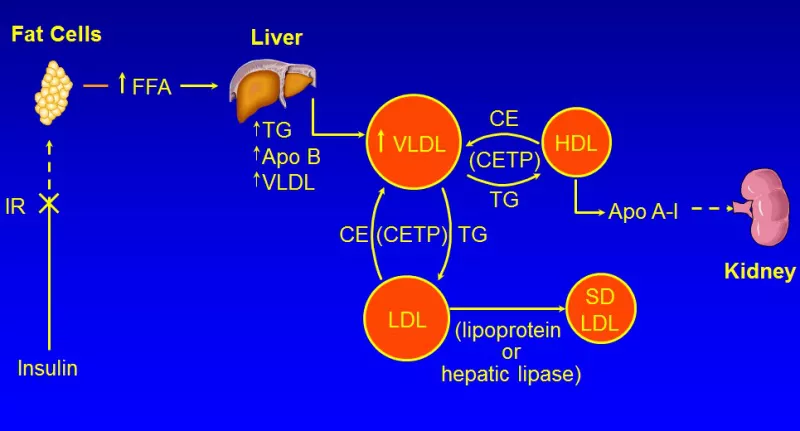Type 2 hyperlipidemia, also known as familial combined hyperlipidemia, is a genetic disorder characterized by elevated levels of cholesterol and triglycerides in the blood. This condition increases the risk of developing cardiovascular diseases, such as coronary artery disease and stroke. Type 2 hyperlipidemia is one of the most common inherited lipid disorders, and its management requires a multifaceted approach involving lifestyle changes, medication, and regular monitoring.
What Are The Treatments for Type 2 Hyperlipidemia?
Dietary Changes
One of the primary treatments for type 2 hyperlipidemia is adopting a heart-healthy diet. This involves:
Reducing Saturated and Trans Fats: These fats can raise low-density lipoprotein (LDL) cholesterol levels. Patients should limit intake of red meat, full-fat dairy products, and processed foods.
Increasing Fiber Intake: Soluble fiber can help lower LDL cholesterol. Foods rich in soluble fiber include oats, barley, beans, lentils, fruits, and vegetables.
see also: 7 Ways to Lower Your Cholesterol Levels
Incorporating Healthy Fats: Monounsaturated and polyunsaturated fats found in olive oil, avocados, nuts, seeds, and fatty fish (like salmon and mackerel) can improve lipid profiles.
Limiting Cholesterol Intake: While dietary cholesterol has a smaller effect on blood cholesterol levels compared to saturated and trans fats, it’s still beneficial to moderate consumption of cholesterol-rich foods such as organ meats and shellfish.
Avoiding Sugary Foods and Beverages: High intake of sugars can raise triglyceride levels. Patients should minimize consumption of sugary drinks, candies, and desserts.
Regular Physical Activity
Engaging in regular physical activity is crucial for managing type 2 hyperlipidemia. Exercise helps lower triglycerides, increase high-density lipoprotein (HDL) cholesterol, and improve overall cardiovascular health. Recommendations include:
Aerobic Exercise: Activities such as brisk walking, jogging, swimming, or cycling for at least 150 minutes per week (moderate-intensity) or 75 minutes per week (vigorous-intensity).
Strength Training: Incorporating muscle-strengthening activities at least twice a week.
Weight Management
Maintaining a healthy weight is essential for managing hyperlipidemia. Weight loss can significantly improve lipid levels, especially triglycerides. A weight loss of 5-10% of total body weight can have a meaningful impact on cardiovascular risk.
Smoking Cessation
Smoking cessation is imperative for patients with type 2 hyperlipidemia. Smoking lowers HDL cholesterol and increases the risk of cardiovascular disease. Quitting smoking can improve lipid profiles and overall heart health.
Alcohol Consumption
Moderate alcohol consumption may have a beneficial effect on HDL cholesterol levels, but excessive drinking can raise triglycerides and lead to other health problems. Patients should limit alcohol intake to no more than one drink per day for women and two drinks per day for men.
Pharmacological Treatments
When lifestyle modifications alone are insufficient to manage type 2 hyperlipidemia, medications may be necessary. The choice of medication depends on the specific lipid abnormalities and the patient’s overall cardiovascular risk.
Statins
Statins are the most commonly prescribed medications for lowering LDL cholesterol. They work by inhibiting HMG-CoA reductase, an enzyme involved in cholesterol synthesis in the liver. Common statins include atorvastatin, simvastatin, and rosuvastatin. Statins can also modestly reduce triglycerides and increase HDL cholesterol.
Ezetimibe
Ezetimibe works by inhibiting the absorption of cholesterol from the intestine. It is often used in combination with statins to achieve greater reductions in LDL cholesterol.
PCSK9 Inhibitors
PCSK9 inhibitors, such as alirocumab and evolocumab, are monoclonal antibodies that help reduce LDL cholesterol levels by increasing the liver’s ability to remove LDL from the blood. They are typically used in patients who do not achieve their lipid goals with statins and ezetimibe or in those who are statin-intolerant.
Bile Acid Sequestrants
Bile acid sequestrants, such as cholestyramine, colestipol, and colesevelam, work by binding to bile acids in the intestine, preventing their reabsorption. This leads to increased cholesterol clearance from the blood. These medications can lower LDL cholesterol but may raise triglycerides, so they are used with caution in patients with high triglycerides.
Niacin
Niacin, also known as vitamin B3, can help lower triglycerides and LDL cholesterol while raising HDL cholesterol. However, its use is limited by side effects such as flushing, itching, and gastrointestinal issues. Niacin is typically used when other treatments are inadequate.
Fibrates
Fibrates, such as fenofibrate and gemfibrozil, are particularly effective at lowering triglycerides and increasing HDL cholesterol. They work by activating peroxi
some proliferator-activated receptors (PPARs), which play a role in lipid metabolism. Fibrates are often used in patients with high triglycerides and low HDL cholesterol.
Omega-3 Fatty Acids
Prescription omega-3 fatty acids, such as icosapent ethyl and omega-3-acid ethyl esters, can significantly reduce triglyceride levels. They are usually prescribed for patients with very high triglycerides who are at risk of pancreatitis.
Combination Therapy
In some cases, combination therapy may be necessary to achieve optimal lipid control. This can involve using two or more medications with different mechanisms of action. For example, a statin may be combined with ezetimibe or a PCSK9 inhibitor to achieve greater LDL cholesterol reduction.
Monitoring and Follow-Up
Regular monitoring of lipid levels and cardiovascular risk factors is essential for patients with type 2 hyperlipidemia. This includes periodic blood tests to measure cholesterol and triglyceride levels, as well as monitoring for potential side effects of medications.
Individualized Treatment Plans
Treatment plans for type 2 hyperlipidemia should be individualized based on the patient’s specific lipid abnormalities, overall cardiovascular risk, and response to therapy. Factors such as age, family history, comorbid conditions, and personal preferences should be considered when developing a treatment strategy.
Conclusion
Managing type 2 hyperlipidemia requires a comprehensive approach that includes lifestyle modifications, pharmacological treatments, and regular monitoring. By adopting a heart-healthy diet, engaging in regular physical activity, maintaining a healthy weight, and adhering to prescribed medications, patients can significantly reduce their risk of cardiovascular disease. Collaboration between patients and healthcare providers is crucial for developing and maintaining an effective treatment plan tailored to the individual’s needs.

